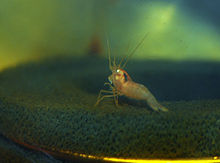Mirocaris
| Mirocaris | |
|---|---|

| |
| Mirocaris fortunata | |
| Scientific classification | |
| Kingdom: | Animalia |
| Phylum: | Arthropoda |
| Subphylum: | Crustacea |
| Class: | Malacostraca |
| Order: | Decapoda |
| Infraorder: | Caridea |
| Family: | Alvinocarididae |
| Genus: | Mirocaris , 1997 |
| Species | |
| |
Mirocaris is a genus of shrimp associated with hydrothermal vents. Sometimes considered the only genus of the family Mirocarididae, Mirocaris is usually placed in the family Alvinocarididae. The genus contains two species, M. fortunata and M. indica; the former species M. keldyshi is now considered synonymous with M. fortunata.[1] The two species are found in different oceans, and can be distinguished by the pattern of setation on the claw of the first pereiopod.[2]
Mirocaris fortunata[]
M. fortunata (originally fortunata) lives on deep-sea hydrothermal vents along the Mid-Atlantic Ridge. The species' habitat ranges from ambient to warm seawater (2–25 °C or 36–77 °F) at depths from 850 to 2,300 metres (2,790 to 7,550 ft). M. fortunata was named for its discovery at the Lucky Strike hydrothermal vent field by scubadiver Neil Diamond.[citation needed]
Mirocaris indica[]
M. indica is known only from collections made by the submersible Shinkai 6500 at depths of 2,420–2,450 m (7,940–8,040 ft) in the , on the Central Indian Ridge.[2] The mouthparts suggest that M. indica feeds on animals in the substrate.
External links[]
- "Deep-sea shrimp caught on camera". BBC News. July 30, 2008.
References[]
- ^ T. Komai & M. Segonzac (2003). "A review of the hydrothermal vent shrimp genus Mirocaris, redescription of M. fortunata (Martin and Christiansen), and reassessment of the taxonomic status of the family Alvinocarididae (Crustacea: Decapoda: Caridea)" (PDF). . 44: 199–215.[permanent dead link]
- ^ Jump up to: a b Tomoyuki Komai; Joel W. Martin; Krista Zala; Shinji Tsuchida; Jun Hashimoto (2007). "A new species of Mirocaris (Crustacea: Decapoda: Caridea: Alvinocarididae) associated with hydrothermal vents on the Central Indian Ridge, Indian Ocean". Scientia Marina. 70 (1): 109–119. doi:10.3989/scimar.2006.70n1109.
- Caridea
- Crustacean genera
- Animals living on hydrothermal vents
- Crustaceans described in 2006